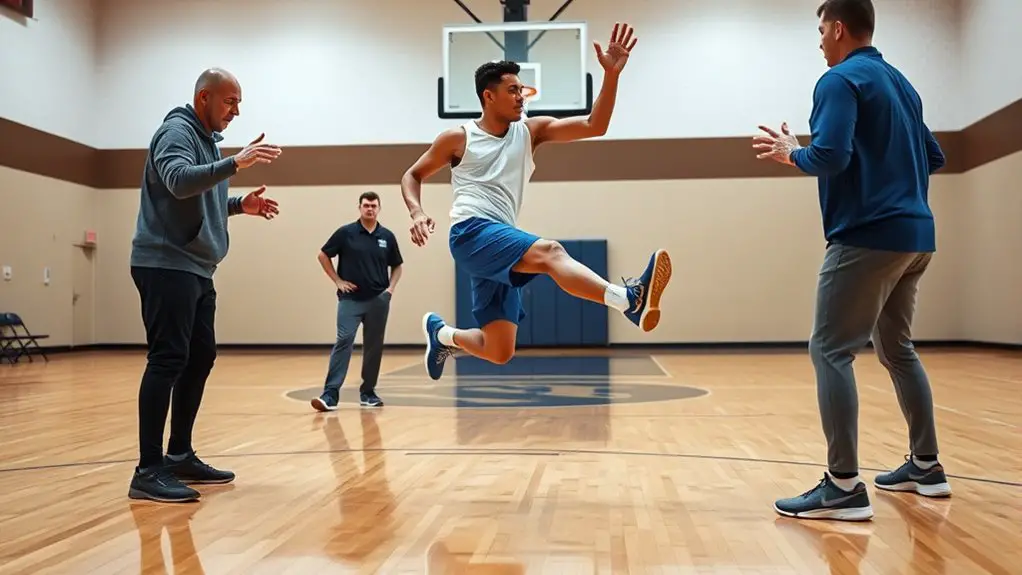To recover quickly after high-intensity workouts, prioritize hydration and nutrition. Drink water and replenish lost electrolytes. Eat a balanced meal rich in protein, healthy fats, and carbohydrates within an hour of exercising. Incorporate active recovery techniques like stretching, low-intensity cardio, and foam rolling to boost circulation and reduce soreness. Don't forget the importance of rest and quality sleep for muscle repair. Listen to your body and include recovery days for ideal results. There's more to explore!
Hydration: The Key to Recovery
When you push your body to its limits during high-intensity workouts, staying properly hydrated is essential for effective recovery. Water helps flush out toxins, aids in nutrient transport, and keeps your muscles functioning efficiently. Without adequate hydration, you might experience fatigue, cramping, and longer recovery times, which can feel like a cage when you crave freedom in your fitness journey. Aim to drink water before, during, and after your workouts. Listen to your body; if you're feeling thirsty, it's a sign you need more fluids. Consider adding electrolytes to your water, especially after intense sessions, to replenish what you've lost through sweat. Remember, hydration isn't just about quenching your thirst; it's about fueling your freedom to move, explore, and thrive in your workouts. By prioritizing hydration, you're setting yourself up for success, ensuring you bounce back stronger and ready for your next adventure. Staying hydrated supports the freedom to perform at your best, allowing you to maintain focus and energy throughout your fitness journey.
Nutrition: Fueling Your Body
After an intense workout, what you eat can make a big difference in your recovery. Timing your post-workout meal and including essential nutrients are key to replenishing your body and promoting muscle repair. Proper nourishment enhances recovery and boosts performance, so it's important to focus on what you consume. Let's explore how to optimize your nutrition for the best results.
Post-Workout Meal Timing
To maximize recovery and muscle gains, timing your post-workout meal is vital. Eating within 30 to 60 minutes after intense exercise guarantees your body gets the nutrients it craves for peak recovery. This window is significant as your muscles are primed to absorb nutrients efficiently.
Here's a quick guide to meal timing:
| Time Post-Workout | Recommended Action |
|---|---|
| 0-30 minutes | Consume a quick snack (like a protein shake) |
| 30-60 minutes | Have a balanced meal with carbs and protein |
| 60+ minutes | Don't skip, but focus on regular meals |
Essential Nutrients for Recovery
While you might feel great after a high-intensity workout, your body needs the right nutrients to fully recover and rebuild. To fuel your freedom, focus on three vital nutrients: protein, carbohydrates, and healthy fats.
Protein aids in muscle repair, helping you bounce back stronger. Aim for lean sources like chicken, fish, or plant-based options. Carbohydrates replenish glycogen stores, giving your body the energy it craves; think whole grains, fruits, and veggies. Healthy fats, found in avocados and nuts, support overall recovery and hormonal balance.
Hydration's essential, too—water helps transport these nutrients throughout your body. Incorporate these elements into your post-workout meals, and you'll not only recover faster but also enhance your performance for the next adventure. Embrace your freedom in fitness!
Active Recovery Techniques
Active recovery techniques are essential for helping your body bounce back after tough workouts. Incorporating stretching, low-intensity cardio, and foam rolling can greatly enhance your recovery process. Additionally, active recovery promotes blood flow, which is crucial for effective recovery. Let's explore how these methods can keep you feeling fresh and ready for your next session.
Stretching and Mobility Work
Since your body goes through significant stress during high-intensity workouts, incorporating stretching and mobility work into your recovery routine is essential. These techniques help release tension, improve flexibility, and enhance overall movement quality. You'll feel more liberated as your muscles recover and regain functionality.
Here's a quick reference table to guide your stretching and mobility work:
| Stretch Type | Duration | Frequency |
|---|---|---|
| Static Stretching | 15-30 seconds | Post-workout |
| Dynamic Stretching | 5-10 minutes | Before workouts |
| Foam Rolling | 1-2 minutes | 2-3 times a week |
| Yoga Poses | 5-20 minutes | Daily |
| Mobility Drills | 5-10 minutes | 3-4 times a week |
Embrace these practices for an easier recovery!
Low-Intensity Cardio Activities
Incorporating low-intensity cardio activities into your recovery routine can greatly enhance your overall recovery process. Think of activities like walking, cycling at a leisurely pace, or swimming gently. These exercises keep your blood flowing without putting too much stress on your body, helping to flush out toxins and reduce soreness. You don't have to hit the gym; just enjoy a stroll in the park or ride your bike around the neighborhood. The key is to maintain a pace where you can still hold a conversation. This way, you're allowing your muscles to recover while staying active and feeling free. So, embrace these low-key workouts and let your body heal while enjoying the movement.
Foam Rolling Techniques
After engaging in low-intensity cardio, adding foam rolling to your recovery routine can take your muscle recovery to the next level. Foam rolling helps release tension and improve blood flow, so your muscles can bounce back faster. Here are three techniques to try:
- Quads: Roll from your hips to your knees, adjusting pressure by shifting your body weight.
- Hamstrings: Sit on the floor, placing the foam roller under your thighs. Roll from your knees to your glutes.
- Back: Lie on your back with the roller under your shoulder blades. Roll gently, allowing your spine to relax.
Incorporating these techniques can enhance your freedom in movement and make you feel revitalized after those intense workouts!
Stretching and Mobility Work
While many athletes focus on pushing their limits during high-intensity workouts, neglecting stretching and mobility work can hinder recovery and overall performance. Incorporating these practices into your routine helps you maintain flexibility, reduce soreness, and prevent injury.
Here's a simple guide to get you started:
| Stretching Technique | Mobility Exercise |
|---|---|
| Static Stretching | Hip Circles |
| Dynamic Stretching | Arm Swings |
| Foam Rolling | Leg Swings |
| PNF Stretching | Torso Twists |
After your workout, take time to stretch major muscle groups, holding each stretch for 15-30 seconds. For mobility, integrate dynamic movements that mimic your workout patterns. This combination not only enhances your range of motion but also boosts your overall freedom to move, letting you enjoy your fitness journey fully. Prioritizing mobility training can significantly enhance your recovery process and overall performance.
Rest and Sleep Importance
Rest and sleep are essential components of recovery that you shouldn't overlook, especially after intense workouts. Without adequate rest, your body won't fully recover, leading to fatigue and decreased performance. Prioritizing quality sleep can help you feel energized and ready to tackle your next challenge. Here are three key reasons why rest and sleep matter:
- Muscle Repair: Your muscles need time to heal and grow stronger after the stress of high-intensity workouts. Sleep is when this repair happens.
- Hormonal Balance: Sufficient sleep helps regulate hormones like cortisol and growth hormone, which are vital for recovery and overall well-being.
- Mental Clarity: A well-rested mind enhances focus and motivation, keeping you engaged in your fitness journey. Additionally, sleep plays a crucial role in reducing inflammation, which improves strength and endurance.
Ice Baths and Contrast Therapy
Ice baths and contrast therapy are two popular recovery techniques that can greatly enhance your post-workout routine. If you're looking to reduce soreness and speed up recovery, these methods are worth considering. Ice baths involve immersing yourself in cold water, which helps constrict blood vessels and decrease inflammation. You'll feel a rush as your body adapts, and once you warm up, blood flow returns, flushing out toxins. Additionally, incorporating cold therapy into your routine can invigorate your muscles and sharpen your focus.
On the other hand, contrast therapy alternates between hot and cold water. This method stimulates circulation and helps your muscles recover faster. You can switch between hot and cold showers or use hot packs followed by cold compresses. Both techniques can enhance your freedom to pursue high-intensity workouts without the dread of prolonged soreness. So, give ice baths or contrast therapy a try; your body will thank you, making each workout a step closer to your fitness goals.
Foam Rolling and Massage
After exploring the benefits of ice baths and contrast therapy, another effective recovery method to contemplate is foam rolling and massage. Both techniques can help you release tension, improve blood flow, and speed up recovery, allowing you to feel free and ready for your next workout.
Here are three key benefits of foam rolling and massage:Discover the top three benefits of foam rolling and massage for enhanced recovery and performance.
- Increased Flexibility: Regular foam rolling can enhance your range of motion, making movements easier and more fluid during your workouts.
- Reduced Muscle Soreness: Targeting tight areas helps alleviate soreness and stiffness, so you can bounce back faster after intense sessions.
- Improved Circulation: Both methods promote better blood flow, ensuring that your muscles receive the nutrients they need for peak recovery. Additionally, foam rolling performs self-myofascial release, which breaks up knots and further aids in muscle relaxation.
Incorporating foam rolling and massage into your routine can be a game changer, helping you maintain your freedom to move and perform at your best.
Listening to Your Body
How can you truly know when your body needs a break? It's all about tuning in to those subtle signals. If you're feeling unusually fatigued, sore, or irritable, it might be time to slow down. Your body communicates through aches, pains, and even mood changes, so don't ignore those whispers. When you push too hard, you risk burnout, which can stifle your freedom and joy in fitness.
Notice how your body responds during and after workouts. Are you recovering slower than usual? Are you lacking motivation? These are signs that your body might be asking for a pause. Embrace the power of self-awareness; it's your best tool for sustainable progress. By listening to your body, you'll not only enhance your recovery but also discover a more enjoyable and liberating approach to your fitness journey. Remember, true strength comes from understanding your limits and respecting them. Additionally, rest days are essential for overall training success and recovery, contributing to your long-term fitness goals.
Incorporating Recovery Days
Recognizing when your body needs a break is just the first step; incorporating recovery days into your routine is where the real magic happens. These days aren't just about doing nothing; they're vital for your overall progress and well-being. Here's how to make the most of them:
- Active Recovery: Engage in low-intensity activities like walking, yoga, or swimming. This keeps your body moving without overexerting it.
- Prioritize Sleep: Quality rest is essential. Aim for 7-9 hours to allow your muscles to repair and rejuvenate, as sleep allows the body to repair and rebuild muscles effectively.
- Nutrition Focus: Fuel your body with nutrient-dense foods. Incorporate proteins, healthy fats, and plenty of fruits and veggies to support recovery.
Frequently Asked Questions
How Do I Know if I'm Overtraining?
When you feel like you're running on empty, "too much of a good thing" might apply. If you're experiencing fatigue, irritability, or persistent soreness, you could be overtraining. Listen to your body; it knows best!
Can Supplements Aid in Recovery?
Supplements can definitely aid in recovery, but you've gotta choose wisely. They might help reduce inflammation and replenish nutrients. Just remember, they shouldn't replace a balanced diet or proper rest; those are essential too.
What Role Does Mental Recovery Play?
You might think mental recovery doesn't matter, but it's key. Your mind's clarity boosts motivation and resilience, helping you embrace freedom in your workouts. Balance your mindset, and you'll find recovery feels less like a chore.
How Often Should I Implement Recovery Techniques?
You should implement recovery techniques regularly, ideally after every intense session. Listen to your body; if you're feeling fatigued or sore, don't hesitate to incorporate more recovery days. It's all about balance and freedom!
Are There Specific Recovery Strategies for Different Sports?
Oh sure, just throw a blanket recovery method over all sports! But seriously, different activities demand tailored strategies—like yoga for runners or foam rolling for weightlifters. Your body craves specific care, so listen to it.




